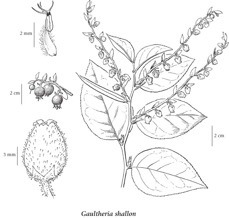– S a l a l –

Common Name(s):
Salal
Scientific Name(s):
Gaultheria shallon
First Nation Name(s):
Hulkemel’em name:
- Upriver Hulkemel’em name(s): t’eqe’ (fruit), t’eqe:lph (shrub)
- Downriver Hulkemel’em name(s): t’eqe’ (fruit), t’eqe’elhp (shrub)
- Island Hulkemel’em name(s): t’eqe’ (fruit), t’eqe’ulhp (shrub)
Family:
Ericaceae

Botanical Description:
Salal is a prolific, creeping to erect shrub that usually reaches 30 to 50 cm tall with the potential of reaching 2 meters in humid conditions. When young, the bark stems are greenish-red and later develop a grey, woody appearance by its third or fourth year. Salal leaves are alternate, evergreen, thick, shiny, and oval-shaped that are sharply and finely toothed. They are rounded or heart-shaped at the base and are roughly 3-9 cm long and 1.5-6.5cm long (Klinkenberg, 2017). Its white or pink urn-shaped flowers are 5 lobed and grow to 7-9 mm long. It grows in long clusters on a stalk that bends to orient them in one direction. The fleshy berries vary between a reddish-blue, dark blue-ish black, and contain minute seeds that give them a grainy texture (Turner, 1995).
Cautions:
None
Current Distribution and Local Habitat(s):
Salal is among the most common forest understorey shrub within British Columbia (Pojar, MacKinnon, & Alaback, 1994). It grows in dense thickets across the humid coastal forested and logged over areas along the Pacific coast from Southern California to Southern Alaska (Hobby, Dow, & MacKenzie, 2010). It is also common from along rocky bluffs, to the seashore among low to medium elevations. Within British Columbia, salal is common along the coast to up to 55° latitude and can stretch across the east to as far as the slopes of the Coast and Cascade mountains. It has also been found in the interior wet belt at Kooteny Lake. (Turner, 1995)
Ethnobotanical Use(s):
Berries
Salal berries are the most plentiful and widely used fruit among the Northwest coastal indigenous groups. They were picked by the cluster in late summer, and eaten both fresh and dried within a cake during the winter. Once the berries were mashed, the procedure for preparing the salal cakes either required them to stand for a few days or were boiled within boxes on hot rocks. These cakes were highly prized, with only the top-quality cakes put aside for family meals or gifts for chiefs. The Kwakwa̱ka̱ʼwakw people ate the ripe berries dipped in oolichan grease during large feasts. Salal berries were also used by the Haida as a natural sweetener and thickener for salmon eggs. For trading and selling purposes, ripe salal berries were mixed with either currants or elderberries to make them last longer. In more recent times, the berries are still consumed in the form of jams and preserves. However, many who are unfamiliar to the berry consider it inferior to other fruits due to its gritty minute seeds (Turner, 1995).
Leaves
The salal leaves were and continue to be just as prized as the berries. The Ditidaht people made use of the young leaves as a thirst suppressant by chewing generous amounts, and the leafy branches were used in pit-cooking and as a flavor component in fish soups. A small makeshift drinking cup was also formed by the rolling of the salal leaf into a cone. Then beginning in the early twentieth century, the commercial harvesting of salal as a floral greenery component emerged. It’s long-lasting, glossy, dark leaves are highly sought after as it provides a structural and elegant component in flower arrangements. (Hobby, Dow, & MacKenzie, 2010).
View Presentation of how to make salal granola bars with salal berries
UVic Campus Location(s):
Salal can be found around the First Peoples House, within the Fraser Woods, and around the Ian Ross Memorial Garden.
Written by:
Leanna McKnight
Figure Reference(s)
http://3.bp.blogspot.com/-jZohhj5IRi0/USoJXFp_jjI/AAAAAAAAFFU/vZiBipcwYJU/s1600/Salal02.jpg
http://linnet.geog.ubc.ca/Images/Drawings/big/PDERI0F060.jpg
References:
Hobby, Dow, & MacKenzie, (2010). Commercial development of salal on southern Vancouver Island. BC Journal of Ecosystems and Management 11 (1&2):62-71. http://jem.forrex.org/index.php/jem/article/view/57/28.
Klinkenberg, Brian. (Editor) 2017. E-Flora BC: Electronic Atlas of the Plants of British Columbia[eflora.bc.ca]. Lab for Advanced Spatial Analysis, Department of Geography, University of British Columbia, Vancouver
Pojar, J., MacKinnon, A., & Alaback, P. B. (1994). Plants of coastal British Columbia (pp. 53). Vancouver, BC: Lone Pine Publishing.
Turner, N.J. (1995). Food plants of coastal First Peoples (No. 34., pp. 77-78). UBC Press.
https://books.google.ca/books?hl=en&lr=&id=h5FrgwZwx1wC&oi=fnd&pg=PR5&dq...
Project Status:
Year:
Associated Projects:
Image:

